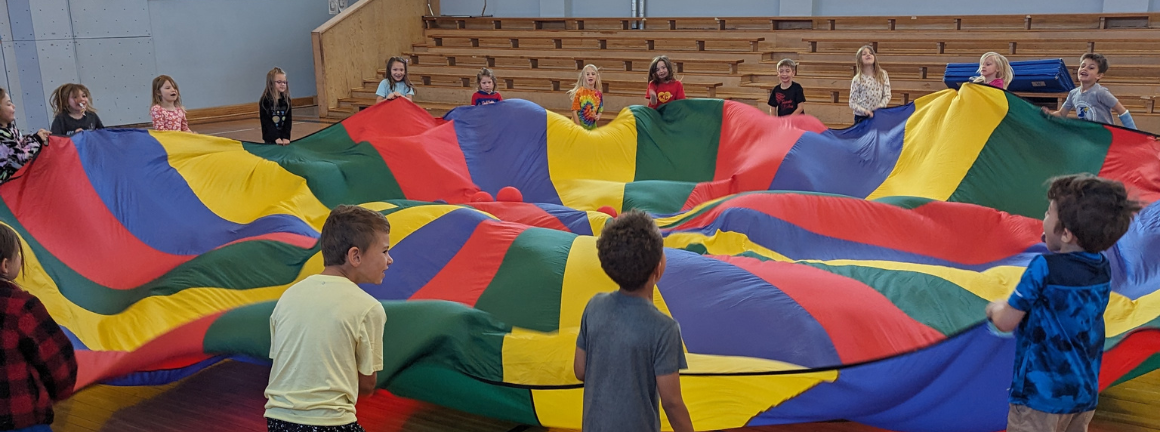District Wellness Policy
Local Health and Wellness
The board is committed to providing a school environment that promotes student health and wellness as part of the total learning experience for its students. To this end, the board shall promote and monitor a local health and wellness plan that includes methods to promote student health and wellness, prevent and reduce childhood obesity, and provide assurance that school meals and other food and beverages sold and otherwise made available on the school campus during the school day are consistent with applicable minimum federal standards. The plan shall:
- Include goals for providing proper student nutrition promotion and education, physical activity, and other school-based activities designed to promote student wellness which are based on evidence-based strategies and techniques;
- Meet federal nutrition standards and guidelines for all foods and beverages provided to students in each school during the school day;
- Ensure standards and nutrition guidelines for all foods and beverages sold to students during the school day at each district school are consistent with the requirements of the School Breakfast Program, the National School Lunch Program, and the competitive food standards established pursuant to the National School Lunch Program;
- Provide students with opportunities to improve personal health and disease prevention;
- Develop essential health skills necessary to maintain and enhance personal and community health behaviors;
- Include goals for addressing student social and mental health needs;
- Develop skills to prevent injury; and
- Understand the effects and consequences of nicotine, alcohol, and drug use.
The Superintendent or designee shall be responsible for the implementation and oversight of this policy and plan to ensure each of the district’s schools, programs, and curriculum is compliant with this policy, the plan, and existing law and regulations.
Each building principal or designee shall annually report to the superintendent or designee regarding compliance in his/her school. Staff members responsible for programs related to school health and wellness shall also report to the superintendent or designee regarding the status of such programs. The superintendent or designee shall then annually report to the board on the district’s compliance with law, policy, and the district’s plan related to school wellness.
Health and Wellness Committee
The board shall establish a health and wellness committee comprised of, but not necessarily limited to, at least one of each of the following: school board member, district administrator, district food service representative, student, parent/guardian, school health professional, physical education teacher, and member of the public.
The health and wellness committee shall serve as an advisory committee regarding student health issues and shall be responsible for developing, implementing, and periodically reviewing and updating a school health and wellness policy and plan that complies with law to recommend to the board for adoption.
The health and wellness committee shall review and consider evidence-based strategies and techniques in establishing goals for nutrition education and promotion, physical activity, and other school-based activities that promote student health and wellness as part of the policy and plan development and revision process.
The superintendent or designee and the health and wellness committee shall conduct an assessment at least once every three (3) years on the contents and implementation of this policy and plan as part of a continuous improvement process to strengthen them and ensure proper implementation. This triennial assessment shall be made available to the public in an accessible and easily understood manner and include:
- The extent to which district schools are in compliance with law, policy, and its plan related to school health and wellness;
- The extent to which this policy and plan compare to model local health and wellness policies; and
- A description of the progress made by the district in attaining the goals of this policy.
At least once every three (3) years, the district shall update or modify this policy and health and wellness plan based on the results of the most recent triennial assessment and/or as district and community needs and priorities change; health and wellness goals are met; new health science, information, and technologies emerge; or new federal or state guidance or standards are issued.
The district shall annually inform and update the public, including parents/guardians, students, and others in the community, about the contents, updates and implementation of this policy and plan via the district website, student handbooks, newsletters, or other efficient communication methods. This annual notification shall include information on how to access the school health and wellness policy and plan; information about the most recent triennial assessment; information on how to participate in the development, implementation, and periodic review and update of the school health and wellness policy and plan; and a means of contacting health and wellness committee leadership.
Recordkeeping
The district shall retain records documenting compliance with the requirements of the school health and wellness policy, which shall include:
- The written school health and wellness policy and plan;
- Documentation demonstrating that the district has informed the public, on an annual basis, about the contents of the school health and wellness policy and plan and any updates to these documents;
- Documentation of efforts to review and update the school health and wellness policy and plan, including who was involved in the review and methods used by the district to inform the public of their ability to participate in the review; and
- Documentation demonstrating the most recent assessment on the implementation of the school health and wellness policy and plan and notification of the assessment results to the public.
Approved: 8/09; 6/15; 12/15; 6/17; 12/20
DISTRICT HEALTH AND WELLNESS PLAN
The board offers the following district health and wellness plan as a supplement to its health and wellness policy, JGCA. This plan reflects some of the board’s elected methods to promote student health and wellness, prevent and reduce childhood obesity, and provide assurance that school meals and other food and beverages sold and otherwise made available on the school campus during the school day are consistent with applicable minimum federal standards. This plan is periodically revised in accordance with policy JGCA. Questions concerning its contents may be directed to the superintendent.
NUTRITION PROMOTION AND EDUCATION
Designated instructional staff will integrate nutrition education into the district’s sequential, comprehensive health education program. The program will be reviewed and updated, as appropriate.
Nutrition education will be interactive and will endeavor to provide students with the knowledge and skills needed to adopt healthy eating behaviors.
Nutrition education may be provided in school cafeterias, as well as in the classroom, with coordination between the food service personnel and teachers.
The district will provide appropriate training to the staff members responsible for providing nutrition education and training to students on strategies for promoting healthy eating behaviors.
Consistent nutrition messages will be disseminated throughout the district, schools, classrooms, cafeterias, homes, and community utilizing one or more of the following methods:
- Handouts;
- Posters and bulletin boards;
- Postings on the district’s website;
- Articles and information provided in district or school newsletters;
- Presentations that focus on nutritional value and healthy lifestyles;
- Special programs that highlight aspects of nutrition education; and
- News media.
Lessons and Activities
District staff will develop and implement nutrition education lessons and activities for all grades that are appropriate to the student’s age and developmental levels.
Instructional staff will be requested to integrate nutritional themes into daily lessons and activities, as appropriate, to complement the academic standards based on nutrition education. Nutritional themes may include, but are not limited to:
- Knowledge of USDA dietary guidelines;
- Sources and variety of foods;
- Guide to a healthy diet, including snacks and the importance of breakfast;
- Concepts of control and prevention of disease and nutritional deficiencies;
- Use and misuse of dietary supplements;
- Understanding calories;
- Understanding and using food labels;
- Essential nutrients and their relationship to physical performance and body composition;
- Appreciating cultural diversity related to food and eating;
- Recognizing appropriate serving sizes;
- Safe food preparation, handling, and storage; and
- Identifying and limiting junk food.
District staff members are expected to be supportive in helping students to practice the nutritional themes used in lessons and activities.
Family and Community Involvement
The superintendent or designee will be responsible for promoting family and community involvement in supporting and reinforcing nutrition education in the schools utilizing one or more of the following methods:
- Nutrition education materials are sent home with students, posted in school buildings, and made available on the district’s website;
- Parents/Guardians are encouraged to send healthy snacks/meals to school;
- Families are invited to attend any exhibitions of student nutrition projects or health fairs;
- Nutrition education workshops and screening services may be offered;
- Links with nutrition service providers (e.g., qualified public health and nutrition professionals) may be established on the district’s website to inform families about supplemental nutritional services available in the community;
- Nutrition education curriculum may include homework that students can do with their families, such as:
- Reading and interpreting food labels,
- Reading nutrition-related articles, and
- Preparing healthy recipes; and
- School staff members will be encouraged to cooperate with other agencies and community groups to provide opportunities for student projects related to nutrition, as appropriate.
PHYSICAL ACTIVITY
Developmentally appropriate physical activities during the school day for students will be designed to achieve optimal health, wellness, fitness, and performance benefits, and may include the following:
- Daily school-wide exercise program for students in which all students participate in their classrooms;
- Physical activity breaks for students between lessons or classes, as appropriate; activities will be planned to maximize student participation;
- Providing information to parents/guardians that encourages students’ physical activity outside the school environment, such as outdoor play at home, sports, recreation programs, before and after-school programs, community programs, etc.;
- Establishing guidelines governing the age-appropriate physical activity opportunities for students that will be provided in each school;
- Offering and supervising walking programs for students on school property before school, at lunch, or after school;
- Daily recess periods for elementary school students featuring time for unstructured but supervised active play;
- Introducing physical activities other than competitive sports to students;
- Organizing and supervising walking trains for students going to and coming home from school;
- Programs conducted before and after school in district facilities providing developmentally appropriate physical activities to students in an effort to promote physical activity. Designated staff will meet with providers of before and after-school programs in district facilities to discuss and support opportunities for physical activity for attendees;
- Sending students home with suggestions for physical activities for use by parents/guardians through:
- Monthly suggested activity calendars,
- Periodic information and updates,
- Notices of family activity events taking place in the schools or community;
- Promoting the use of school facilities by students and the community for physical activity, fitness, sports, and recreation programs offered by district schools and/or community-based organizations outside of school hours through:
- Announcements,
- Posted notices,
- Newsletters,
- District’s website,
- District’s calendar,
- News media.
PHYSICAL EDUCATION
Professional staff will provide physical education instruction that complies with the established curriculum and academic standards to ensure that students develop required skills and knowledge.
The physical education curriculum and program will be reviewed and updated, as appropriate.
District schools will encourage all students to participate in physical education classes.
Physical education staff will utilize appropriate instructional strategies that provide meaningful inclusion of all students, regardless of skill or fitness level.
The district’s physical education programs will:
- Provide physical activity options and alternatives from a variety of categories such as outdoor, rhythmical, and lifetime;
- Feature cooperative as well as competitive games;
- Teach self-management skills as well as movement skills;
- Actively teach cooperation, fair play, and responsible participation;
- Promote participation in physical activity outside of school;
- Endeavor to be an enjoyable experience for students;
- Encourage lifelong participation in health-enhancing physical activities;
- Attempt to create a positive learning environment in which students feel safe and supported; and
- Utilize physical activities that are developmentally appropriate.
Suitably adapted physical education will be included, when practicable, as part of a student’s IEP, Section 504 Plan, or accommodation when chronic health problems, disabling conditions, or other special needs preclude such student’s participation in regular physical education instruction or activities. Documented medical conditions and disabilities will be accommodated in accordance with the applicable IEP or Section 504 Plan.
An annual assessment and inventory of equipment, facilities, and resources used for physical education courses will be made by physical education staff. Equipment, facilities, and resources determined to be obsolete, out-of-date, unusable, or unsafe will be reported for disposition.
Physical education staff will attend professional development opportunities and inservice programs, in accordance with board policy.
District schools will discourage the withholding or use of physical education solely as a form of punishment.
Student physical activity on school grounds during school hours will be supervised to enforce safety rules and to attempt to prevent injuries.
Building administrators are encouraged to notify district staff that physical activity (e.g., recess) will not be used or withheld as a form of punishment;
Assessment
A local assessment system may be implemented to track student progress on the Health and Physical Education academic standards. Course grades will be awarded in the same manner grades are awarded in other subject areas and will be included in calculations of grade point average, class rank, and academic recognition programs.
Family and Community Involvement
To promote family and community involvement in supporting and reinforcing physical education in the schools, the building principal or designee will be responsible for ensuring that:
- Physical education activity ideas are sent home with students;
- Parents/Guardians are actively encouraged to promote their child’s participation in the school’s physical education programs and any after-school activities through information distributed by the school;
- Families are invited to attend and participate in physical education activity programs and health fairs when held;
- Physical education curriculum may include homework that students can do with their families.
- School staff is encouraged to consider student preferences and interest when developing physical education programs.
- School staff is encouraged to work with local recreation agencies and community organizations to provide opportunities for students to participate in physical activity programs outside of school.
OTHER SCHOOL BASED ACTIVITIES
Drinking water shall be available and accessible to students, without restriction and at no cost to the student, at all meal periods and throughout the school day.
Nutrition professionals who meet hiring criteria established by the district and in compliance with federal regulations shall administer the school meals program. Professional development and continuing education shall be provided for district nutrition staff, as required by federal regulations.
- Students shall be provided a clean and safe meal environment.
- District administrators may consider offering alternative service models to increase school breakfast participation, such as breakfast served in the classroom and “grab & go breakfast” to reinforce the positive educational, behavioral, and health impacts of a healthy breakfast.
- Students shall have access to hand washing or sanitizing before meals and snacks.
- Access to the food service operation shall be limited to authorized staff.
- Nutrition content of school meals shall be available to students and parents/guardians upon request.
- The district shall provide appropriate training to staff on the components of the school health and wellness policy and plan.
- Fundraising projects submitted for approval shall be supportive of healthy eating and student health and wellness or at least neutral on that topic.
- The district shall support the efforts of parents/guardians to provide a healthy diet and daily physical activity for children by communicating relevant information through various methods.
FUNDRAISERS
Fundraising projects must be submitted for district approval in accordance with district policy. School fundraising activities will be approved with consideration of the following:
- Fundraising activities held during the school day involving the sale of food or beverages will be limited to foods that meet the USDA Smart Snacks in School nutrition standards, unless an exemption is approved by the building principal;
- Availability of any food or beverage items sold as part of a fundraising activity will be restricted until at least thirty (30) minutes after the last lunch period;
- Fundraising activities that promote physical activity will be encouraged; and
- District staff members are encouraged to select foods and beverages which are low in sugar and fat content to be sold as part of any fundraisers for school sponsored activities, programs, or events outside of the school day.
For purposes of this regulation, school day means the period from midnight before school begins until thirty (30) minutes after the end of the official school day.
Copies of this administrative regulation will be available in the central office and will be distributed to activity sponsors, student treasurers of school activities, and other interested individuals and groups.
Exempt fundraiser foods or beverages may not be sold in competition with school meals in the food service area during the meal service.
NUTRITION GUIDELINES FOR ALL FOODS/BEVERAGES AT SCHOOL
All foods and beverages available in district schools during the school day shall be offered to students with consideration for promoting student health and reducing obesity.
Foods and beverages provided through the National School Lunch or School Breakfast Programs shall comply with established federal nutrition standards.
Foods and beverages offered or sold at school-sponsored events outside the school day, such as athletic events and dances, shall offer healthy alternatives in addition to more traditional fare.
Competitive Foods
Competitive foods available for sale shall meet or exceed the established federal nutrition standards (USDA Smart Snacks in School). These standards shall apply in all locations and through all services where foods and beverages are sold to students, which may include, but are not limited to: a la carte options in cafeterias, vending machines, school stores, snack carts, and fundraisers conducted during the school day.
Competitive foods are defined as foods and beverages offered or sold to students on school campus during the school day, which are not part of the reimbursable school breakfast or lunch.
For purposes of this policy, school campus means any area of property under the jurisdiction of the school that students may access during the school day.
For purposes of this policy, school day means the period from midnight before school begins until thirty (30) minutes after the end of the official school day.
The district may impose additional restrictions on competitive foods, provided that the restrictions are not inconsistent with federal requirements.
Non-Sold Competitive Foods
Non-sold competitive foods available to students, which may include but are not limited to foods and beverages offered as rewards and incentives, at classroom parties and celebrations, or as shared classroom snacks, shall meet or exceed the standards established by the district.
If the offered competitive foods do not meet or exceed the Smart Snacks in School nutrition standards, the following standards shall apply:
- Rewards and Incentives:
- Foods and beverages shall not be used as a reward or incentive in district schools.
- Foods and beverages shall not be used as a reward for classroom or school activities unless the reward is an activity that promotes a positive nutrition message (e.g., guest chef, field trip to a farm or farmers market, etc.).
- Classroom Parties and Celebrations:
- Parents/Guardians shall be informed through newsletters or other efficient communication methods that foods/beverages should only be brought in when requested for scheduled parties.
- Classroom parties shall offer a minimal amount of foods (maximum 2-3 items) containing added sugar as the primary ingredient (e.g., cupcakes, cookies) and will provide the following:
- Fresh fruits/vegetables; and
- Water, 100 percent juice, 100 percent juice diluted with water, low-fat milk, or nonfat milk.
- Shared Classroom Snacks:
- Shared classroom snacks are not permitted in district schools
The district shall provide a list of suggested nonfood ideas and healthy food and beverage alternatives to parents/guardians and staff, which may be posted via the district website, student handbook, newsletters, posted notices and/or other efficient communication methods.
Marketing/Contracting
Any foods and beverages marketed or promoted to students on the school campus during the school day shall meet or exceed the established federal nutrition standards (USDA Smart Snacks in School) and comply with established Board policy and administrative regulations.
Exclusive competitive food and/or beverage contracts shall be approved by the board, in accordance with provisions of law. Existing contracts shall be reviewed and modified to the extent feasible to ensure compliance with established federal nutrition standards, including applicable marketing restrictions.
SAFE ROUTES TO SCHOOL
District schools may provide appropriate instruction on walking and bicycling safety to students.
To make walking and biking to school safer and easier for students, improvements to school zone traffic safety may be made by:
-
- Developing drop-off and pick-up procedures and informing students, parents/guardians, and district staff by means of:
- Publication in handbooks;
- Reminders to parents/guardians in the form of letters or emails at the start of each school term and as necessary throughout the school year;
- Presentation at a student assembly;
- Presentation at a parents meeting; and/or
- Posting of notice/signs.
- Designating a drop-off and pick-up zone to discourage traffic congestion in front of schools;
- Conducting regular traffic safety training for school personnel, volunteers, and students who drive to school;
- Encouraging carpooling to alleviate traffic congestion in front of schools;
- Staggering school arrival and dismissal times for different grades to minimize the flow of traffic; and
- Using a designated employee, parent/guardian, or volunteer at drop-off locations to open the student’s door and expedite the drop-off process.
- Developing drop-off and pick-up procedures and informing students, parents/guardians, and district staff by means of:
Designated school personnel, police, and volunteers may periodically evaluate drop-off and pick-up conditions and provide safety information and instruction to drivers.
The Superintendent or designee may meet periodically with local municipality officials, law enforcement, and community organizations to develop, evaluate, and maintain safe routes to school.
In cooperation with the local ordinances and laws, physical improvements such as curb striping and signage revision may be made to the school’s drop-off and pick-up zones and/or parking and stopping spots.
PERSONAL AND COMMUNITY HEALTH
The district will provide a framework to educate, support, and promote health enhancing behaviors and programs for students levels. Research demonstrates that healthy students do better in school and score higher on achievement tests. Parents should be involved with the health education provided to their students. Students will be provided opportunities to learn and understand personal health, prevention and control of disease, the dangers of substance use, abuse and additions, mental and emotional health, injury prevention and safety, and community health needs which may include:
- Major body systems, functions, and relationships between systems;
- Healthy personal hygiene habits;
- Importance of personal health and seeking health care;
- Value of and recommended sleep amounts;
- Health and unhealthy habits;
- Leading causes of death and risk behaviors;
- Disease prevention skills;
- Communicable and noncommunicable diseases;
- Relationship between nutrition, exercise, and disease prevention;
- Structure and functions of the immune system;
- Drug types and dangers of alcohol, tobacco, and other illegal drugs;
- Refusal skills;
- Physical and psychological addictions;
- Cumulative risk behaviors;
- Addictive substances and effect on health;
- Personal strategies for drug free living;
- Communicating care, consideration, and respect;
- Developing stress management skills;
- Avoiding negative self-talk, self-harm, and suicide;
- Developing positive body image and self-esteem;
- Expressing feelings, wants and needs in a health manner;
- Role of the individual in maintaining a healthy community;
- Local community health needs, issues, and events; and
- Opportunities to develop and maintain a healthy community.
Approved: 12/20










